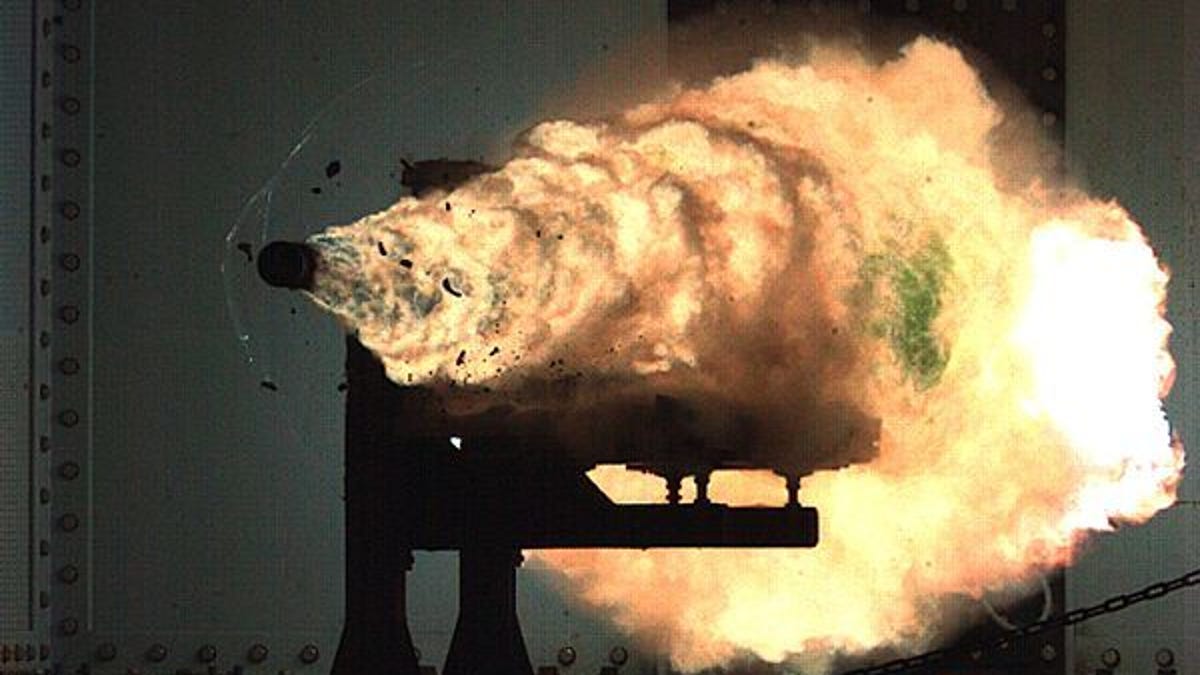Navy tests railgun that can shoot up to 100 miles
The Office of Naval Research is evaluating railgun prototypes from BAE Systems and General Atomics. One test has just been completed, and another will take place in April.

The U.S. Navy says it has tested one of two prototypes of its futuristic electromagnetic railgun, a weapon that could fire a 5-inch projectile up to 100 miles, yet which requires no explosives to fire.
The Office of Naval Research is evaluating competing railguns--one from BAE Systems, and one from General Atomics. Yesterday, ONR announced it has completed a successful test of BAE's model, and the Navy is expected to test-fire General Atomics' offering sometime in April.
"The firing at Naval Surface Warfare Center Dahlgren Division...kicks off a two-month-ling test series by [ONR] to evaluate the first of two industry-built launchers," the Navy said in a release. "The tests will bring the Navy closer to a new naval gun system capable of extended ranges against surface, air, and ground targets."
Instead of employing explosives to shoot projectiles the way conventional naval weapons do, the railgun utilizes an electromagnetic system that depends on the ship's onboard electrical power grid to fire the gun. It uses what's called a pulse-forming network that stores up electrical power and then converts it to a pulse that is directed into the railgun's barrel, John Cochran, the railgun program manager at Raytheon's Advanced Technology Group, told CNET last month.
Cochran said that the process is similar to that of a car's starter, and the way that turning the ignition shoots a jolt of electricity into the solonoid, creating a magnetic field in the solonoid/starter system. For the railgun, current is sent into the barrel, creating a magnetic field, and that, in combination with the current, fires the projectile at between 4,500 miles an hour and 5,600 miles an hour, according to the ONR.
The ONR said this week that the BAE gun is a 32-megajoule prototype. "One megajoule of energy is equivalent to a one-ton car being thrust at" 100 miles an hour, the ONR said in its release.
But the Navy and its contractors appear to figure the estimated range of the experimental weapon differently. A month ago, Raytheon--which is also working on railgun technology--told CNET that it could potentially fire 5-inch projectiles 220 miles. In its own release, however, ONR stuck to the more conservative 100-mile range.
When the railgun is deployed in 2025 or so, it could be used in several ways. Roger Ellis, the ONR railgun program manager told CNET, said it could be fired inland from naval ships in support of marines as they come ashore. Another possibility, Ellis said, would leverage the railgun's long range, allowing the Navy to defend its ships from seaborne threats long before they get into range.
During the current phase of testing, the Navy wants to ensure that it's possible to fire a railgun at a rate of 10 rounds per minute, Ellis told CNET, as well as to evaluate the railgun for thermal and cooling.
Regardless of the outcome of the current testing, Ellis said that though the railgun could be ready by 2025, the timing of its actual military deployment will be dependent on financial and political considerations.

